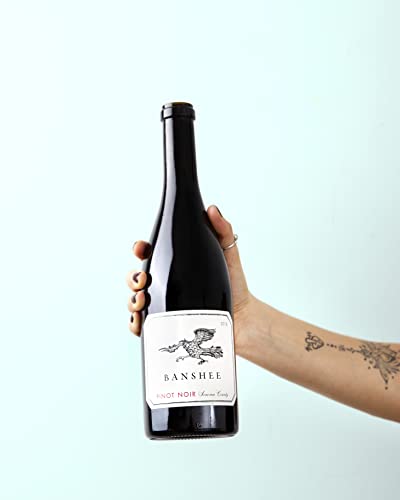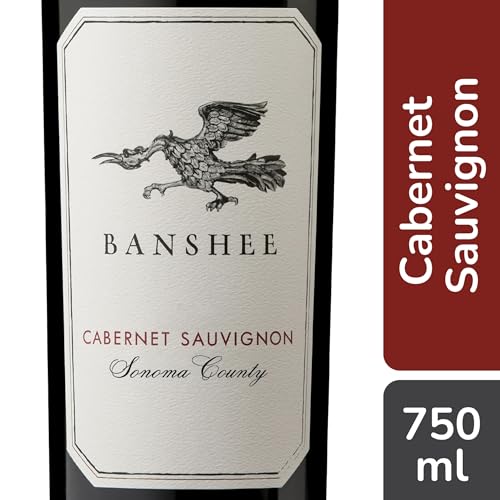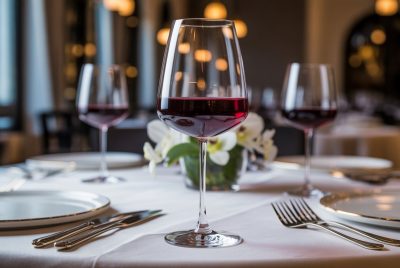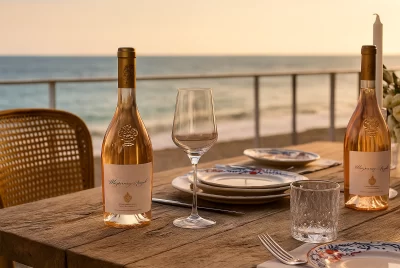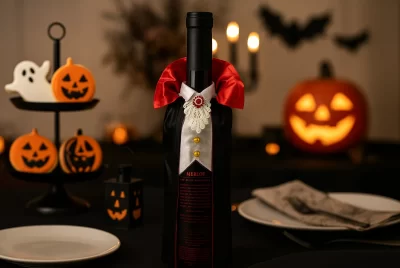Banshee Wines: California’s Boutique Journey
Post Disclaimer
*We may earn a commission for purchases made using our links. Please see our disclosure to learn more.
After years of exploring California’s wine scene, I’ve come to appreciate wineries that strike the perfect balance between quality and affordability. One that consistently stands out is Banshee Wines, a hidden gem that deserves a spot on every wine lover’s radar.
Started in 2009 by three friends with a passion for Sonoma County wines, Banshee set out with a simple goal: to craft exceptional wines without the hefty price tag. What began with a single bottle of Sonoma Coast Pinot Noir has since grown into a diverse collection that highlights the best of California’s terroir while staying true to its roots of quality and value.
Key Takeaways
- Banshee Wines was founded in 2009 by three friends determined to make premium California wines more accessible
- Their portfolio focuses primarily on Pinot Noir, Chardonnay, and Sauvignon Blanc from Sonoma County
- Despite being acquired by Foley Family Wines in 2018, Banshee maintains its boutique approach and quality standards
- Their wines consistently receive critical acclaim while remaining relatively affordable (most bottles range from $20-35)
- Beyond their core offerings, Banshee produces limited-release wines that showcase specific vineyard sites and experimental winemaking techniques
Recommended Banshee Wines
1. Banshee Sonoma County Pinot Noir
A refined yet approachable red wine, Banshee Sonoma County Pinot Noir offers a perfect balance of vibrant fruit flavors and elegant structure. Sourced from premium vineyards in Sonoma County, this Pinot Noir is handpicked and destemmed, then fermented at cool temperatures to enhance its bright, nuanced character. Aged for nine months in French oak (25% new), it delivers layered notes of macerated tart cherries, pomegranate, and earthy pine, all wrapped in a delicate oak finish. Whether paired with rosemary pork, poultry, or pan-seared salmon, this wine brings a touch of Sonoma's finest craftsmanship to your glass.
- Flavor Profile: Bright and fruit-forward with balanced acidity
- Texture: Smooth, elegant texture with a refined oak influence
- Food Pairing: Versatile pairing options for meats, poultry, and seafood
This standout Pinot Noir embodies everything that has made Banshee a favorite among wine lovers. Crafted from hand-selected vineyards across Sonoma County, it delivers impressive depth and complexity at an accessible price point. The nose is layered with enticing aromas of ripe cherry, raspberry, and hints of forest floor, leading into a silky-smooth palate with vibrant acidity and a touch of oak spice.
The well-balanced structure makes it incredibly food-friendly, pairing beautifully with everything from roasted poultry to pan-seared salmon. Consistently earning 90+ point ratings from top wine critics, this is a Pinot Noir that overdelivers on quality and character.
2. Banshee Chardonnay Sonoma +CRV
This beautifully crafted Chardonnay showcases the elegance and vibrancy of Sonoma County. With a focus on balance and purity, Banshee Chardonnay offers a refreshing and fruit-driven profile, making it an excellent choice for both casual sipping and food pairings. Expect bright notes of crisp apple, pear, and citrus, complemented by subtle hints of vanilla and toasted oak. The well-integrated acidity and smooth texture create a clean, refreshing finish that lingers on the palate. Whether enjoyed on its own or paired with seafood, roasted chicken, or creamy pasta dishes, this Chardonnay delivers a delightful and versatile drinking experience.
- Flavor Profile: Crisp apple, pear, and citrus with a touch of oak
- Balance: Smooth texture with well-integrated acidity
- Food Pairing: Complements a variety of dishes, from seafood to creamy pastas
- Oak Influence: May be too lightly oaked for those who prefer bold, buttery Chardonnays
- Availability: Limited production may make it harder to find year-round
- Price: Slightly higher than some entry-level Chardonnays
For those who appreciate a refined and fruit-forward white wine, Banshee Chardonnay offers a beautifully balanced expression of Sonoma County. Crafted with partial malolactic fermentation and just the right touch of oak, it achieves a perfect harmony between richness and freshness. Bright notes of crisp green apple, lemon curd, and a hint of toasted vanilla create a layered and refreshing profile. The result is a Chardonnay that delivers complexity and depth while remaining incredibly approachable, an exceptional value for any white wine lover.
3. Banshee Sauvignon Blanc
This vibrant Sauvignon Blanc from Sonoma County is a refreshing expression of the varietal, crafted with precision to highlight its bright aromatics and crisp acidity. Whole-cluster pressed and fermented in stainless steel, it preserves the fresh, zesty character of the fruit. Expect lively notes of citrus zest, rich lemon curd, and a touch of minerality, with a subtle hint of sea salt that adds intrigue to every sip. Its clean, acid-driven profile makes it a perfect match for shellfish, sushi, Asian cuisine, and light pasta dishes. A beautifully balanced wine that surprises and delights with its refreshing complexity.
- Refreshing Profile: Bright citrus, minerality, and balanced acidity
- Food Pairing: Pairs well with seafood, sushi, and light pasta dishes
- Winemaking Approach: Stainless steel fermentation enhances freshness and aromatics
- Acidity: May be too crisp for those who prefer softer, fruitier whites
- Complexity: Lighter-bodied, which might not appeal to fans of richer white wines
- Availability: Limited production could make it harder to find year-round
For fans of crisp, refreshing white wines, Banshee Sauvignon Blanc delivers a lively and expressive take on this classic varietal. Crafted with stainless steel fermentation to preserve its vibrant character, this wine bursts with citrus zest, lemon curd, and a touch of minerality. A hint of sea salt adds an unexpected twist, making each sip intriguing and refreshing. With its bright acidity and clean finish, it’s a perfect match for seafood, sushi, and light, flavorful dishes, an excellent choice for warm days and fresh pairings.
4. Banshee Paso Robles Cabernet Sauvignon
For those who love rich, full-bodied reds, Banshee’s Paso Robles Cabernet Sauvignon delivers a beautifully layered and complex experience. Aged for six months in French oak, this wine offers deep aromas of ripe fig, cassis, and vanilla, with subtle hints of pine and peppercorn. The palate is juicy and structured, featuring dark plums, spice, and earthy forest floor notes, all wrapped in plush tannins and a smooth, velvety texture. Perfect for pairing with grilled meats, balsamic-glazed lamb, or hearty beef dishes, this Cabernet is a bold yet approachable wine that stands out at any gathering.
- Rich Flavor Profile: Dark fruit, spice, and oak for a complex, layered experience
- Smooth Texture: Plush tannins and a velvety mouthfeel make it easy to enjoy
- Food-Friendly: Pairs exceptionally well with grilled meats and bold flavors
- Oak Influence: May be too pronounced for those who prefer lighter, fruit-forward reds
- Tannin Structure: Could feel slightly firm for those who favor softer Cabernets
- Aging Potential: Best enjoyed young rather than cellared for extended aging
Banshee’s Paso Robles Cabernet Sauvignon showcases the best of California’s signature red, offering depth and approachability in every sip. Less overpowering than some Napa counterparts but richer than many Sonoma versions, this wine strikes a perfect balance. Ripe cassis, dark plum, and vanilla intertwine with hints of spice and earthy forest floor, all wrapped in a smooth, velvety texture. The result is a Cabernet that delivers bold flavor without overwhelming the palate, making it a fantastic choice for both casual sipping and pairing with hearty dishes.
The Banshee Story: From Passion Project to Wine Industry Success
When I first encountered Banshee Wines at a small San Francisco wine bar over a decade ago, I had no idea I was witnessing the early days of what would become one of California’s most intriguing wine success stories. Founded in 2009 by Noah Dorrance, Baron Ziegler, and Steve Graf, Banshee emerged during a challenging economic period when many consumers were scaling back on luxury purchases.
“We wanted to make wines we’d want to drink and could actually afford,” Dorrance once explained in an interview I read. This straightforward philosophy resonated with me immediately. As someone who appreciates quality wine but balks at triple-digit price tags, their approach felt like a breath of fresh air in an increasingly expensive wine landscape.
The founders’ backgrounds weren’t traditional for the wine industry. None came from winemaking families or had formal enology education. Instead, they brought experience from wine sales, marketing, and a genuine passion for Pinot Noir. This outsider perspective ultimately proved advantageous, allowing them to question established practices and focus directly on what consumers like myself were seeking.
Their first release, a Sonoma Coast Pinot Noir, quickly gained attention for delivering remarkable quality at an approachable price. Rather than owning vineyards, they established relationships with top growers throughout Sonoma County, enabling them to source exceptional fruit without the enormous capital investments that drive up prices.
The Winemaking Approach: Minimal Intervention, Maximum Expression
What I find particularly compelling about Banshee’s winemaking philosophy is their commitment to minimal intervention. Working with talented winemakers like Alicia Sylvester, they focus on letting the vineyard sites express themselves authentically.
For their Pinot Noir program—which remains their flagship—this means gentle handling of the fruit, native yeast fermentations when possible, thoughtful oak aging (typically with only 20-30% new French oak), and minimal fining or filtering. The result is wines that express their terroir honestly without excessive winemaker manipulation.
Their Chardonnay similarly showcases restraint, avoiding the over-oaked, buttery style that dominated California for years. Instead, they aim for brightness and mineral character alongside the natural richness of Sonoma Coast fruit.
During a visit to their Healdsburg tasting room a few years ago, I was struck by how their winemaking team described their process as “intentional but not interventional.” This nuanced approach allows for guidance of the wine’s development while respecting the inherent qualities of each vintage and vineyard.
Vineyard Sources: The Foundation of Quality
Though Banshee doesn’t own extensive vineyard holdings, their careful selection of vineyard partners forms the backbone of their quality. Their sourcing focuses primarily on cool-climate regions of Sonoma County, particularly the Sonoma Coast and Russian River Valley AVAs.
These areas offer the perfect conditions for their signature varieties. The maritime influence creates the extended growing season and temperature moderation that Pinot Noir and Chardonnay crave. For their Sauvignon Blanc, they often source from slightly warmer sites that develop more expressive aromatics while maintaining crucial acidity.
What impresses me most about their vineyard program is the long-term relationships they’ve cultivated with growers. Unlike some négociant operations that simply buy fruit opportunistically, Banshee works collaboratively with vineyards year after year. This approach allows them to provide input on farming practices and secure consistent access to premium blocks.
Some of their single-vineyard releases showcase specific sites that demonstrate exceptional character. The Marine Layer Pinot Noir, for example, highlights vineyards directly influenced by the Pacific Ocean’s cooling fog, resulting in wines of remarkable tension and complexity.
The Tasting Experience: Approachable Yet Complex
One aspect I particularly appreciate about Banshee wines is their immediate approachability combined with genuine complexity. Unlike some high-end wines that require years of cellaring before showing their potential, Banshee’s offerings deliver pleasure from release while still providing development in the bottle.
Their Sonoma County Pinot Noir exemplifies this balance. Upon opening, it presents welcoming aromas of cherry, raspberry, and subtle spice. With time in the glass, additional layers emerge—forest floor, rose petal, and mineral notes that speak to its coastal origins. The texture achieves that elusive silkiness that great Pinot Noir is known for, without feeling heavy or extracted.
The Chardonnay similarly strikes a beautiful balance. It offers enough richness to satisfy those who enjoy the variety’s natural generosity, alongside bright acidity and mineral tension that make it remarkably food-friendly.
For those seeking more powerful expressions, their Mordecai red blend delivers concentration and depth while maintaining freshness. By combining Bordeaux varieties like Cabernet Sauvignon and Merlot with Rhône varieties such as Syrah and Grenache, they’ve created a distinctly Californian wine that showcases the state’s diversity.
Beyond the Bottle: Building a Brand and Community
Beyond the wines themselves, I find Banshee’s approach to branding refreshingly unpretentious. From their tasting room in downtown Healdsburg (which feels more like a comfortable living room than a formal wine space) to their evocative but straightforward labels, everything about their presentation emphasizes accessibility without sacrificing sophistication.
This approach has helped them build a loyal following among both casual wine drinkers and serious collectors. Their Wine Club offers exceptional value with customization options that respect members’ preferences, something I wish more wineries would adopt.
When Foley Family Wines acquired Banshee in 2018, many followers (myself included) worried the brand might lose its distinctive character. However, the original team carefully structured the acquisition to preserve their winemaking approach and brand ethos. While the founding partners have moved on to new ventures, the spirit of Banshee continues under thoughtful stewardship.
Sustainability Practices: Responsibility in Winemaking
As someone who believes strongly in environmental stewardship, I appreciate Banshee’s commitment to sustainable practices. While not certified organic or biodynamic across their entire range (primarily because they work with multiple vineyard partners with varying practices), they prioritize vineyards that employ responsible farming methods.
Their winery operations focus on reducing water usage, minimizing chemical inputs, and decreasing their carbon footprint through thoughtful packaging choices and distribution strategies. As climate change increasingly affects wine regions, these practices become not just ethically important but essential for ensuring consistent quality.
Conclusion: Why Banshee Deserves Your Attention
After following Banshee Wines for over a decade, I remain impressed by their commitment to their founding vision. In a wine world often dominated by marketing hype and inflated prices, they continue to deliver authentic, terroir-driven wines that overdeliver for their price points.
Whether you’re just beginning your wine journey or have an extensive cellar, Banshee offers something worthy of your attention. Their core portfolio provides exceptional everyday drinking options, while their limited releases reward deeper exploration of California’s diverse growing regions.
As wine pricing continues to climb throughout premium regions, producers like Banshee who maintain a commitment to value become increasingly important. They remind us that exceptional wine experiences need not be limited to special occasions or extraordinary budgets.
The next time you’re considering a bottle for dinner or looking to explore California wines, I highly recommend seeking out Banshee. Their wines not only deliver immediate pleasure but also tell the story of passionate people committed to making great wine accessible to all who appreciate it.
Frequently Asked Questions
1. Is Banshee an actual winery or just a brand that sources grapes?
Banshee began as a négociant operation, meaning they purchased grapes rather than growing them. However, they’ve evolved to include long-term contracts with specific vineyards and blocks, giving them significant input on farming practices. While they don’t own extensive vineyard holdings, they maintain a dedicated production facility in Sonoma County where all winemaking occurs under their direct supervision.
2. How did Banshee Wines get its unusual name?
The founders chose the name “Banshee” as a nod to Celtic mythology, where these spirits were known for their haunting wails. The name reflects both the founders’ appreciation for Irish heritage and the haunting, memorable quality they strive for in their wines. The slightly mysterious name also stands out in a region filled with family surnames and château-inspired titles.
3. How do Banshee wines compare to other Sonoma County producers?
Banshee wines typically offer exceptional value compared to many Sonoma producers working with similar vineyard sources. While their wines display distinct Sonoma County character (particularly their Pinot Noir and Chardonnay), they generally show a slightly more approachable style than some ultra-premium producers. Their winemaking emphasizes balance and drinkability while still showcasing vineyard character.
4. Are Banshee wines meant to be aged or consumed young?
Most Banshee wines are crafted to be enjoyable upon release while still having the structure and balance to develop for 3-7 years, depending on the bottling. Their core Sonoma County offerings deliver immediate pleasure but can certainly improve with 2-3 years of proper storage. Their single-vineyard and reserve bottlings typically have greater aging potential, with some capable of developing for 7-10 years or longer.
5. Has the quality of Banshee wines changed since the Foley Family acquisition?
Based on my tastings before and after the 2018 acquisition by Foley Family Wines, the overall quality and style consistency has been maintained. The transition appears to have been managed thoughtfully, with the winemaking approach and vineyard sourcing remaining largely consistent. The primary changes seem to involve expanded distribution and production capabilities rather than significant stylistic shifts. If anything, their quality has become more consistent as they’ve gained access to additional resources while maintaining their original vision.




